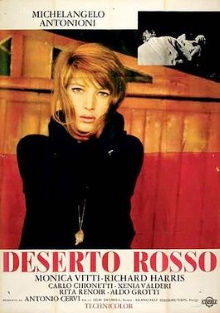Since I’ve developed an appreciation for the films of Michelangelo Antonioni, it makes sense to want to see more of his acclaimed films. Red Desert is the director’s first color film and I think even that fact holds significance in the film itself. Unfortunately I found it difficult to parse the director’s intended meaning here beyond a general indictment of industrialization and a nascent environmentalist message. Such a reading feels a little facile to me however and indeed the director himself insists that is not the whole story. Certainly this isn’t going to be one of my favorites.
Giuliana is the mother of a young son and wife to Ugo who owns a large, petrochemical plant. A fellow industrialist friend Corrado to ask for help finding workers. Corrado seems interested at Giuliana when he sees her and is not dissuaded when Ugo explains that her behavior has been erratic since a car accident that didn’t cause any physical injuries but gave her a shock. Giuliana and Corrado spend more time together, first at the shop she is renovating and later when Corrado goes to a nearby town to recruit an especially valued worker. Giuliana reveals her seemingly irrational and inexplicable fears of being lost and alone as she is surrounded by the large structures of the modern industrial age. Later the two of them plus Ugo and another couple join together in a small shack by the port for a social gathering. It begins with food and drink but the conversation soon takes a turn towards sex and the group even seems to become physically comfortable with one another. Giuliana seems to be able to relax in their company and Corrado seems to want to make a move on her but then the arrival of a large cargo ship distracts everyone.
This one once again stars Antonioni regular Monica Vitti as Giuliana and she spends pretty much the entire film stumbling around in a fugue, afflicted by an indefinable malaise that she is unable to articulate. Still even if it is never said out loud, we know what her problem is. The huge buildings and structures of her husband’s plant loom in the background, completely out of scale with human dimensions, the equipment and materials they use are so unrecognizable as to resemble alien artifacts, when the group beholds the pollution in the water, Ugo and Corrado dismiss it by saying that the effluvium must end up somewhere. When her son seems to come down with a similar problem, Giuliana tells him a story and the world represented in it is the complete opposite: a beautiful sea, pristine beaches, greenery and tranquility and no human development of any kind in sight. That this film represents a kind of rejection of industrialization changing the landscape of Italy and hence an early form of environmentalism seems like the obvious interpretation to look towards.
Antonioni himself however is indignant that there is more to this film than that and opines that it is more about Giuliana being unable to adapt to the changing circumstances of Italy. This reading suggests that there is nothing inherently wrong with industrialization itself but I don’t believe that this is what is actually shown in the film. While some cinematographers are able to capture a kind of austere beauty in industrial chic, the elements that Antonioni chooses to focus on here, the discolored oil slicks in the water, the sick looking smoke emerging from smokestacks, the incomprehensible strangeness of the equipment, make it difficult to believe that he really weighs both industrial beauty and the beauty of the natural environment equally. This being the director’s first film in color, I would suggest that there is even a kind of Lovecraftian horror element in it. Even as Giuliana is unable to explain what it is that ails her so, as she sees something that no one else can see, it is sometimes shown to the audience as being a purplish, ugly distortion of color in the air. It feels like the injection of color into the director’s cinematographic world is something that he has to struggle to adapt to.
There are still so many things in the film that I don’t understand the purpose of. What’s up with the social gathering that looks like it’s building up to some kind of strange orgy? What is significance of the sudden appearance of a plague ship? Anyway this was still received with critical acclaim and the director seemed to have gone to some unusual lengths to get the color right for what he wanted, down to painting the trees and grass with dull colors. But it feels very experimental to me, as if the director were toying around, wondering what to do with colors. As a result, it seems very different from his other films and so it’s not surprising that I don’t like it much.
